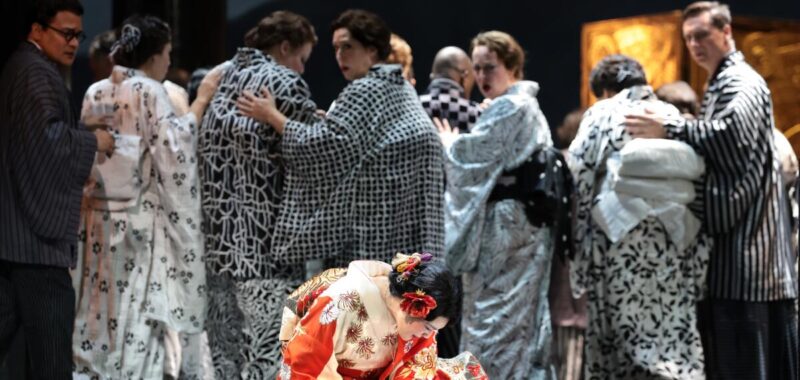
Cio Cio San, a.k.a. Madame Butterfly, first won hearts in an 1898 short story by an American lawyer, then in a Broadway play two years later before becoming immortal thanks to Puccini’s 1904 Italian opera. Cinema was not far behind. By 1932 we had three films: a dreadful 1915 silent starring America’s sweetheart, Mary Pickford; Fritz Lang’s creepily effective 1919 silent, “Harakiri”; and in 1932, the faintly ridiculous early talky with a captivating Sylvia Sidney and the young, debonair-in-the-making Cary Grant.
There was not, in any of these films, an Asian in sight. Indeed, by the 1930s, Hollywood’s Hays Code included among its don’ts miscegenation. In updating “Madame Butterfly” to a 1930s Hollywood soundstage on which Puccini’s opera is being filmed, Los Angeles Opera has made Hays’ don’t an urgent do. Five of the six main Japanese characters are Asian, and an essay in the program booklet calls for removing the “white gaze,” making this a fanciful Hollywood of yore.
The production is an import from Madrid, where it was created 24 years ago by Uruguayan-born Spanish director Mario Gas for Teatro Real. It boasts stunningly colored kimonos designed by Franca Squarciapino, seductive lighting adapted for L.A. by Pablo Santiago and lyrically elegant conducting by music director James Conlon. Yet, none of those is particularly meant to be noticed.
I don’t know how many times I’ve seen “Madame Butterfly” onstage, and I think I’ve seen all the “Butterfly” films. I’ve been mesmerized by the opera (especially the Robert Wilson production at L.A. Opera in 2004). I’ve also been bored by it, infuriated with it, left cold or deeply moved by it. But in every case, I knew how to watch it. You look at the stage. Or do you look at the screen?
In Gas’ production, you look at both, which can take some figuring out. The impressive set by the late Ezio Frigerio is realistically peppered with camera operators and all the other business of filming. But the actual film set is inexplicable, a structure of steel columns that for no particular reason rotates with a painted ocean backdrop behind.
Above the colorful stage is a small screen on which appears to be the black-and-white film as it is being shot, with subtitles under it. It reveals mostly close-ups of the singers, often as filmy cameos like you might see in old silents. Watching the actual set, the supposed filming, is uninvolving. It’s the screen that I finally realized, one act in, you are supposed to watch. You then have an enriched theatrical experience of seeing the film and knowing what went into making it.
What this produces is anachronism upon anachronism. On the set, with actors going through the process, you witness reality. On the screen you get melodrama, it’s artificiality made obvious. But then you get more reality with a live “soundtrack.” And more artificiality. The pit is deep, which makes the orchestra sound thin. The stage has few reflecting surfaces, which makes the singers sound thin. The sync is off for the voices on the film, yet another spanner in the works.
Veteran Korean soprano Karah Son, the Cio Cio San, compensated by forcing. Her vibrato is wide. She is a seasoned Butterfly, having sung it hundreds of times. Her vocal style is Italianate and so, in this production, is her emotive acting. Her voice settled down in the second act, and she brought an appropriately old-fashioned feeling to “Un bel di,” her anticipation of a fine day as hopelessly unreal as everything on the stage. At that moment she could have been an opera singer with all the comfortable mannerisms, powerful and overwrought, of the 1930s.
Tenor Jonathan Tetelman’s Pinkerton is a bit more wooden, but maybe intentionally so. One didn’t feel any real connection between the lovers, but maybe that, too, was wanted, given that the callous American sailor treats marriage to a geisha during a shore leave in Nagasaki as a lark. Sex is another Hays Code don’t.
Many things jar. Becoming an “American” wife, Butterfly exchanges her kimono for a Western dress and can act like a ditzy ‘30s starlet. The deeper characters in this production are her maid, Suzuki, and Sharpless, the American consul. In these roles, Hyona Kim brings a gripping intensity that grounds Butterfly, while Michael Sumuel proves a brilliantly caring foil to Pinkerton‘s superficiality.
Rodell Aure Rosel, as the slimy marriage broker, Goro, and Wei Wu, as the angry monk Bonze, were both characterful in a silent movie kind of way.
What does this all add up to? Teatro Real is done with this production, having replaced it with a grim, gripping one that was live-streamed in July. This reflects the repugnance of sex tourism in today’s Nagasaki, the latest form of white gaze.
In comparison, Gas’ nearly quarter-century-old production really does feel antiquated. But “Butterfly” has lasted by reflecting the blindness of its era, reminding us of our own. It has been looked at from every perspective in a search for transcendence. This production may be a contrivance. The acting comes close to shtick. The singing is not consistently illuminating. Yet, it’s more than a movie.
L.A. Opera has developed an unusually enthusiastic audience, and Saturday night was no exception. The applause was deafening. People do like screens and close-ups, which make opera glasses obsolete. The screen makes it impossible to turn away, forcing you to look, to ponder, to adjust your gaze in ways you might not otherwise. The unreal somehow becomes real.
We can debate about whether it deserves it, but L.A. Opera leaves you wondering and looks to have another hot ticket on its hands.

